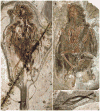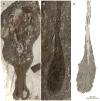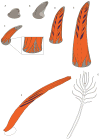Homology and Potential Cellular and Molecular Mechanisms for the Development of Unique Feather Morphologies in Early Birds
- PMID: 24003379
- PMCID: PMC3758748
- DOI: 10.3390/geosciences2030157
Homology and Potential Cellular and Molecular Mechanisms for the Development of Unique Feather Morphologies in Early Birds
Abstract
At least two lineages of Mesozoic birds are known to have possessed a distinct feather morphotype for which there is no neornithine (modern) equivalent. The early stepwise evolution of apparently modern feathers occurred within Maniraptora, basal to the avian transition, with asymmetrical pennaceous feathers suited for flight present in the most basal recognized avian, Archaeopteryx lithographica. The number of extinct primitive feather morphotypes recognized among non-avian dinosaurs continues to increase with new discoveries; some of these resemble feathers present in basal birds. As a result, feathers between phylogenetically widely separated taxa have been described as homologous. Here we examine the extinct feather morphotypes recognized within Aves and compare these structures with those found in non-avian dinosaurs. We conclude that the "rachis dominated" tail feathers of Confuciusornis sanctus and some enantiornithines are not equivalent to the "proximally ribbon-like" pennaceous feathers of the juvenile oviraptorosaur Similicaudipteryx yixianensis. Close morphological analysis of these unusual rectrices in basal birds supports the interpretation that they are modified pennaceous feathers. Because this feather morphotype is not seen in living birds, we build on current understanding of modern feather molecular morphogenesis to suggest a hypothetical molecular developmental model for the formation of the rachis dominated feathers of extinct basal birds.
Keywords: Confuciusornis; Mesozoic birds; Similicaudipteryx; dinosaur integument; feathers; molecular development; rectrix.
Figures









References
-
- Ji Q, Ji SA. On discovery of the earliest bird fossil in China and the origin of birds. Chin Geol. 1996;233:30–33.
-
- Ji Q, Currie PJ, Norell MA, Ji SA. Two feathered dinosaurs from northeastern China. Nature. 1998;393:753–761.
-
- Xu X, Zhao Q, Norell MA, Sullivan C, Hone DW, Erickson GM, Wang XL, Han FL, Guo Y. A new feathered maniraptoran dinosaur fossil that fills a morphological gap in avian origin. Chin Sci Bull. 2009;54:430–435.
-
- Xu X, Zheng XT, You HL. Exceptional dinosaur fossils show ontogenetic development of early feathers. Nature. 2010;464:1339–1341. - PubMed
-
- Zheng XT, You HL, Xu X, Dong ZM. An Early Cretaceous heterodontosaurid dinosaur with filamentous integumentary structures. Nature. 2009;458:333–337. - PubMed
Grants and funding
LinkOut - more resources
Full Text Sources
Research Materials
